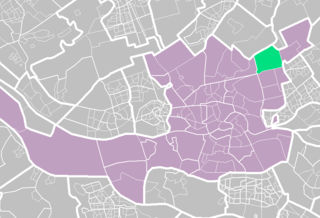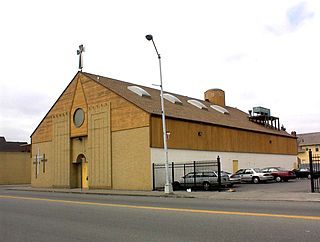
Rotterdam is the second-largest city in the Netherlands after the national capital of Amsterdam. It is in the province of South Holland, part of the North Sea mouth of the Rhine–Meuse–Scheldt delta, via the "New Meuse" inland shipping channel, dug to connect to the Meuse at first and now to the Rhine.

The Hague is the capital city of the South Holland province of the Netherlands. With a population of over half a million, it is the third-largest city in the Netherlands. Situated on the west coast facing the North Sea, The Hague is the country's administrative centre and its seat of government, and while the official capital of the Netherlands is Amsterdam, The Hague has been described as the country's de facto capital since the time of the Dutch Republic.

Demographic features of the population of the Netherlands include population density, ethnicity, education level, health of the population, economic status, religious affiliations and other aspects of the population.

Islam is the second largest religion in the Netherlands, after Christianity, and is practised by 5% of the population according to 2018 estimates. The majority of Muslims in the Netherlands belong to the Sunni denomination. Many reside in the country's four major cities: Amsterdam, Rotterdam, The Hague and Utrecht.

Urban Chinatowns exist in several major European cities. There is a Chinatown in London, England, as well as major Chinatowns in Manchester, Birmingham, Newcastle and Liverpool. In Paris there are two Chinatowns: one where many Vietnamese – specifically ethnic Chinese refugees from Vietnam – have settled in the Quartier chinois in the 13th arrondissement of Paris which is Europe's largest Chinatown, and the other in Belleville in the northeast of Paris. Berlin, Germany has two Chinatowns, one in the East and one in the West. Antwerp, Belgium also has an upstart Chinese community.

Ommoord is a neighbourhood in the former borough Prins Alexander, part of the municipality of Rotterdam, South Holland, the Netherlands. Ommoord is surrounded by the neighbourhoods Zevenkamp, Het Lage Land and Terbregge. It has around 25.000 inhabitants across 12.500 households. Ommoord shares postal codes 3068 and 3069 with Zevenkamp.
Chuts is the name applied to Jews who immigrated to London from the Netherlands in the mid-Victorian era (1850s–1860s). They typically came from the cities of Amsterdam and Rotterdam, and brought to London their trades: most notably those of cigar-, cap-, and slipper-making, and as small-time ship chandlers.

Feijenoord is a district in Rotterdam and is located south of the Nieuwe Maas. As of 1 January 2004 there were 72,320 inhabitants. The area is 6.44 km². It is not the current home of the city's main football club, Feyenoord, which is now in the neighbouring township of IJsselmonde.
Turks in the Netherlands, also Dutch Turks or Turkish Dutch, refers to people of full or partial Turkish ethnicity living in the Netherlands. They form the largest ethnic minority group in the country; thus, the Turks are the second-largest ethnic group in the Netherlands after the ethnic Dutch. The majority of Dutch Turks descend from the Republic of Turkey; however, there has also been significant Turkish migration waves from other post-Ottoman countries including ethnic Turkish communities which have come to the Netherlands from the Balkans, the island of Cyprus, as well as from other parts of the Levant. More recently, during the European migrant crisis significant waves of Turkish minorities from Syria and Kosovo have also arrived in the Netherlands. In addition, there has been migration to the Netherlands from the Turkish diaspora; many Turkish-Belgians and Turkish-Germans have arrived in the country as Belgian and German citizens.
The first mentions of the Baháʼí Faith in the Netherlands were in Dutch newspapers which in 1852 covered some of the events relating to the Bábí movement which the Baháʼí Faith regards as a precursor religion. Circa 1904 Algemeen Handelsblad, an Amsterdam newspaper, sent a correspondent to investigate the Baháʼís in Persia. The first Baháʼís to settle in the Netherlands were a couple of families — the Tijssens and Greevens, both of whom left Germany for the Netherlands in 1937 as business practices were affected by Nazi policies. Following World War II the Baháʼís established a committee to oversee introducing the religion across Europe and so the permanent growth of the community in the Netherlands begins with Baháʼí pioneers arriving in 1946. Following their arrival and conversions of some citizens the first Baháʼí Local Spiritual Assembly of Amsterdam was elected in 1948, with around 11 Baháʼís in the country. By 1962, at the election of its first national spiritual assembly, there were 110 Baháʼís and nine local spiritual assemblies, by 1973 there were 365 Baháʼís and 16 spiritual assemblies, and by 1979 there were 525 Baháʼís and 27 spiritual assemblies. An estimate from 1997 put Baháʼís in The Netherlands at 1500. In 2005 the Netherlands had 34 local spiritual assemblies.

Chaldean Town was a historically Chaldo-Assyrian neighborhood in Detroit located along West Seven Mile Road in a segment in between Woodward Avenue to the west and John R St. to the east. Circa 2007 the population of the district was mainly low income elderly people and recent immigrants, who were mostly made up of Chaldean Catholic Assyrians. The neighborhood was usually just a stop point for newly arrived immigrants, who then typically preferred to move to the suburbs of Detroit when they could afford to.
Multiculturalism in the Netherlands began with major increases in immigration during the 1950s and 1960s. As a consequence, an official national policy of multiculturalism was adopted in the early 1980s. This policy subsequently gave way to more assimilationist policies in the 1990s and post-electoral surveys uniformly showed from 1994 onwards that a majority preferred that immigrants assimilated rather than retained the culture of their country of origin. Even though the general acceptance of immigrants increased, opinion polls from the early 1980s and after showed that many were critical of immigration. Following the murders of Pim Fortuyn and Theo van Gogh the political debate on the role of multiculturalism in the Netherlands reached new heights.

Heijplaat is a neighborhood of Rotterdam, Netherlands.

In 1940, Rotterdam was subjected to heavy aerial bombardment by the Luftwaffe during the German invasion of the Netherlands during the Second World War. The objective was to support the German troops fighting in the city, break Dutch resistance and force the Dutch army to surrender. Bombing began at the outset of hostilities on 10 May and culminated with the destruction of the entire historic city centre on 14 May, an event sometimes referred to as the Rotterdam Blitz. According to an official list published in 2022, at least 1,150 people were killed, with 711 deaths in the 14 May bombing alone, and 85,000 more were left homeless.

The Rotterdam tramway network is a key element of the overall public transport arrangements in Rotterdam, Netherlands.

In March 2017, the Netherlands and Turkey were involved in a diplomatic incident, triggered by Turkish efforts to hold political rallies on Dutch territory and subsequent travel restrictions placed by Dutch authorities on Turkish officials seeking to promote the campaign for a 'yes' vote in the upcoming Turkish constitutional referendum to Turkish citizens living in the Netherlands. Such foreign campaigning is illegal under Turkish law.
The 1999 Rotterdam riots refers to serious riots and clashes between Dutch security forces and football hooligans in Rotterdam, the Netherlands on 26 April 1999.

Fijenoord was a shipbuilding company and machine factory in Rotterdam the Netherlands from 1823 to 1929. In 1929 it merged with Wilton to become Wilton-Fijenoord.

Afrikaanderwijk riots were the first race riots of their kind in the Netherlands. The riots broke out on 10 August 1972 and continued until 16 August in the Afrikaanderwijk, Rotterdam. While their precise cause is unknown, the clashes are considered to be an example of xenophobic violence by some and economic tensions by others. The clashes are known for creating new laws towards the city's growing immigrant population and destroying the stereotype of Dutch tolerance. In 2019, it gained renewed popularity due to the events in Ankara: Islamist and activist organizations used the riots of 1972 as an example to create empathy for the Syrian refugees in Turkey.
The Schiedam riots broke out on 6 August 1976 in Schiedam, Netherlands, when two Dutch teens were stabbed, one fatally, after an argument between two Turkish and five Dutch teens.















